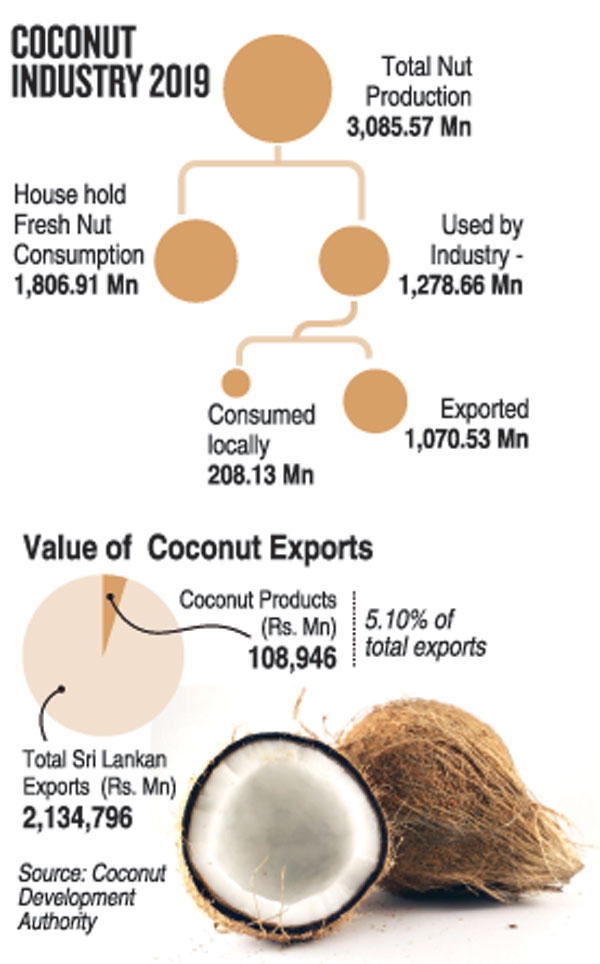News
Untying the knots on nuts: Export demand and hoarding blamed for price hike

CAA official on a coconuts-measuring mission. Pic by Indika Handuwala
Consumer Affairs Authority (CAA) officials were seen in public markets and economic centres this week measuring the circumferences of coconuts using measuring tapes and wireframe rings or what are mockingly called coconut rings to ensure that traders comply with the Government’s maximum-retail price order.
According to CAA Information Director Asela Bandara, the Authority conducted more than 150 successful raids this week in Colombo city and suburbs where residents had complained of high coconut prices.
An extraordinary gazette 2194/73 was issued by the CAA last week, outlining maximum retail prices for coconuts based on the circumference of the nut.
Accordingly, a coconut with a circumference of more than 13 inches should be sold at Rs. 70, a coconut with a circumference between 12 and 13 inches at Rs. 65 and a coconut with a circumference below 12 inches at Rs. 60.
The CAA director said they were told coconut production was enough to meet the local demand and therefore they were of the view the prices should not have gone up drastically. The CAA wanted to make sure the people bought coconut at a reasonable price, he said, justifying the strict measures introduced to provide relief to consumers.
He warned retail traders to adhere to the regulation or face, in the case of a repeat offence, a fine between Rs. 1,000 and Rs. 10,000 and a six-month jail term
Mr. Bandara said that in 2017, the CAA introduced an MRP (maximum retail price) of 75 rupees for all sizes of coconuts but the decision came under heavy criticism due to size variation.
 “This is why this time we introduced three prices depending on the sizes. The Coconut Development Authority issued us the sizes measured in inches as used in the industry. That is the reason, inches have been used instead of centimetres,” he said.
“This is why this time we introduced three prices depending on the sizes. The Coconut Development Authority issued us the sizes measured in inches as used in the industry. That is the reason, inches have been used instead of centimetres,” he said.
“People do not need to carry a coconut ring or measuring tape. This is for traders and investigation officers. Meanwhile, displaying prices by traders is also a must by law,” he said.
Sri Lanka produces about about 3 million nuts a year, with the local household consumption being about 1.8 million. Of the balance 1.2 million, about a million is exported and others are used locally by the industry.
According to the Coconut Research Institute, between January and August this year, there has been an 11 percent decrease in production compared to last year.
This was largely because of the heat wave experienced in February and March this year, CRI Director C.S. Ranasinghe said, adding that usually every year there was also a slight production drop from September to December.
“Though we have enough coconuts to meet the local demand for the next three months, the demand from the export market is growing. As a result of the competition to buy coconuts for the export market, prices have shot up, with middle-men trying to benefit from the high demand,” Dr. Ranasinghe said.
Explaining the reasons for the price control, she said, “We were informed that stocks are being hoarded by unscrupulous traders in the hope the price will increase to about Rs. 100 in December. This is why the decision to issue a gazette was taken. However, by April next year, the supply is forecasted to be normal.”
When asked about the proposal to import coconuts, Dr. Ranasinghe said requests were being made to import frozen kernels from countries such as the Philippines, Indonesia and Vietnam, but “we are of the view that the supply will return to normal by January next year and we need not hurry with the proposal to import the kernel.”
Complaining that good quality coconuts were hardly found in the market, National Movement for Consumer Rights Protection spokesman Ranjith Vidanage said there were signs of a shortage in the coming weeks. “We are getting public complaints from all over the country,” he said
He said that initially traders did not conform to the gazette and sold large coconuts above the maximum retail price, but after the CAA started its raids, they now largely sold smaller ones.

